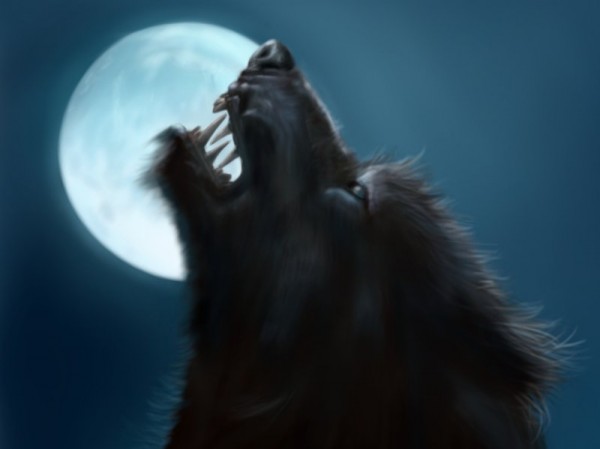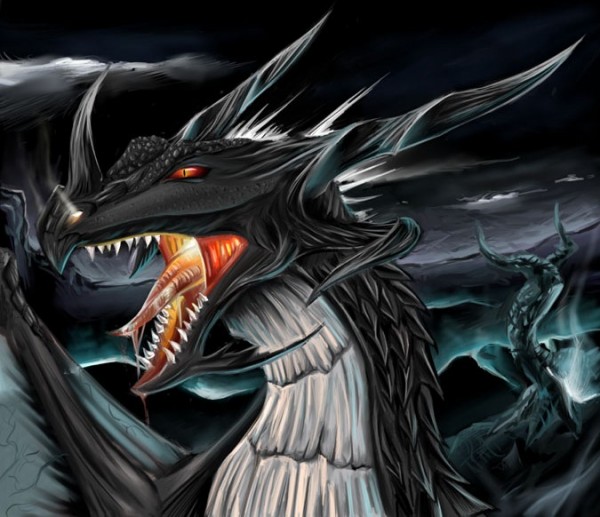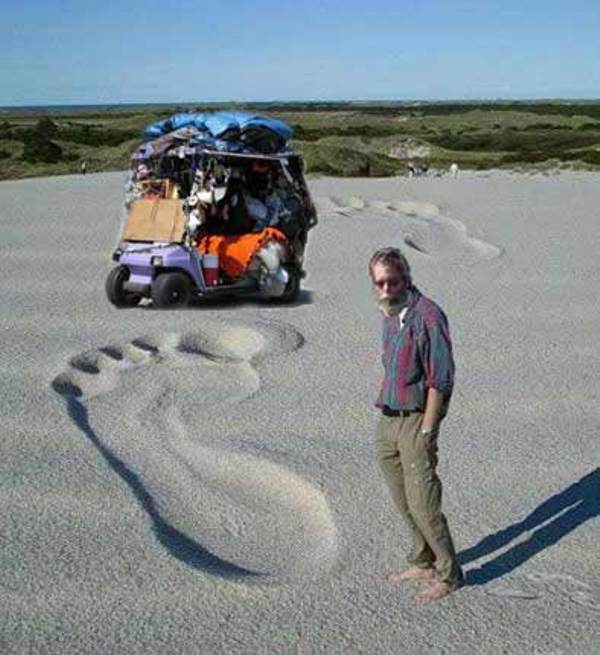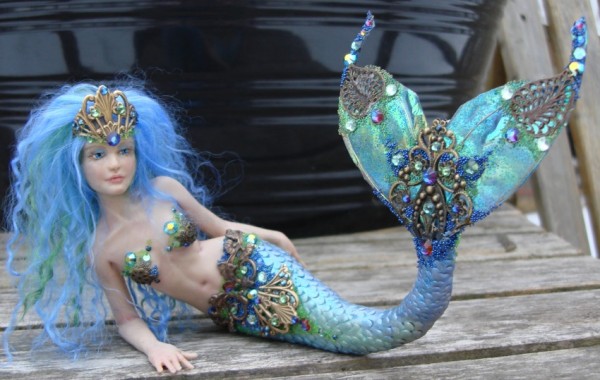Cryptozoology is the “study of hidden animals”. It refers to the search for animals which are considered to be legendary or otherwise nonexistent by mainstream biology. This includes looking for living examples of animals which are extinct, such as dinosaurs; animals whose existence lacks physical support but which appear in myths, legends. Cryptid is a term which is used in cryptozoology to refer to a creature whose existence has been suggested but that is unrecognized by a scientific consensus, and whose existence is moreover often regarded as unlikely but still likely to be engraved in our minds. ????
10. Mothman

Image Source
Other Name: Often associated with Indrid Cold, “The Grinning Man” from John A. Keels book “The Mothman Prophecies”
Status: Unconfirmed
Location: West Virginia, United States
Description: Winged bipedal
The Mothman is a creature reportedly seen in the Point Pleasant area of West Virginia from November 12, 1966, to December 1967. Most observers describe the Mothman as a man-sized creature with large reflective red eyes and large wings. The creature was sometimes reported as having no head, with its eyes set into its chest.
People who have seen the mothman have described him as a 7 foot tall creature, long big wings and huge red eyes. It has an unusual shriek that can be heard from a mile away. It may have gray or light-blue colored skin under its feathers, which also vary in color. It is not known if it has skin like a human or very fine fur on its body. It has great strength as it has been seen lifting an object as heavy as a car. Mothman is often referred to as a male.
9. Giant Anaconda

Image Source
Other Name: Sucuriju Gigante
Status: No specimens above the size of 10.5 metres (34 ft) have been captured
Location: South America
Description: Giant snake
Reports of giant anacondas date back as far as the discovery of South America when sightings of anacondas upwards of 50 meters (150 feet) began to circulate amongst colonists and the topic has been a subject of debate ever since among cryptozoologists and zoologists.
Anacondas normally grow to sizes of 6 metres (20 ft),and 250 kilograms (40 stone) in weight, Although some python species can grow longer, the anaconda, particularly the Green Anaconda, is the heaviest and largest in terms of diameter of all snakes, and is often considered the biggest extant snake in the world. It is not uncommon for a fully grown anaconda to attack and kill a jaguar or caiman. The lengthiest reputably-measured and confirmed anacondas are about 7.5 meters (25 feet) long and scientists generally regard allegations of extraordinary specimens of 30 or 50 feet as highly dubious.
Historian Mike Dash writes of claims of still larger anacondas, alleged to be as long as 45 metres (148 ft) with some of the sightings supported with photos (although those photos lack scale). Dash notes that if reports of a 18 metres (59 ft) anaconda strains credulity, then a 120 feet long specimen is generally regarded as an outright impossibility.
8. Goatman

Image Source
Other Name: The Maryland Goatman, Chevo Man
Status: Unconfirmed
Location: Wisconsin, Maryland, and New York (United States)
Description: Bipedal
The Goatman is a hominid cryptid associated with the state of Maryland in the USA. It is described as a hybrid creature; part man and part goat. Some claim it is a relative of Bigfoot. Its appearance is similar to the satyrs or the god Pan of Greek mythology, or to the Devil. The Goatman of Maryland is often associated with St. Mark the Evangelist school, in the back of the yard where an unknown “house” lies in Prince George’s County, and with the nearby Glenn Dale Hospital, the former site of a state tuberculosis sanatorium. It is reported to have attacked a number of witnesses and to have damaged property. It has also been reported to have killed family pets.
7. Yeti

Image Source
Other Name: Abominable Snowman, Mande Barung
Status: Unconfirmed
Location: Himalayas (Pakistan, Nepal and North East India)
Description: Primate
Yeti or Abominable Snowman mythological humanoid creature said to inhabit the Himalayan region of Pakistan and Nepal. The scientific community largely regards the Yeti as a legend, yet it remains one of the most famous creatures of cryptozoology parallel to Bigfoot of North America. It is tall, bipedal creature covered with long white hair and wore no clothes. He had an interesting feature of changing his hair colour in sunlight to fox red.
6. Chupacabra

Image Source
Other Name: Goat Sucker
Status: Unconfirmed
Location: Mexico/Puerto Rico/Texas, United States/Kerala, India
Description: Reptile//Mammal/Canine, possibly 2 species; thought to be a supernatural/extraterrestrial creature by some
The word chupacabra is from chupar “to suck” and cabra “goat”. It is a legendary cryptid rumored to inhabit parts of the Americas. It is associated more recently with sightings of an allegedly unknown animal in Puerto Rico (where these sightings were first reported), Mexico, and the United States, especially in the latter’s Latin American communities. The name comes from the animal’s reported habit of attacking and drinking the blood of livestock, especially goats. Physical descriptions of the creature vary. Eyewitness sightings have been claimed as early as 1990 in Puerto Rico, and have since been reported as far north as Maine, and as far south as Chile. It is supposedly a heavy creature, the size of a small bear, with a row of spines reaching from the neck to the base of the tail. Biologists and wildlife management officials view the chupacabras as a contemporary legend.
The most common description of chupacabras is a reptile-like being, appearing to have leathery or scaly greenish-gray skin and sharp spines or quills running down its back. This form stands approximately 3 to 4 feet (1 to 1.2 m) high, and stands and hops in a similar fashion to a kangaroo. In at least one sighting, the creature was reported to hop 20 feet (6 m). This variety is said to have a dog or panther-like nose and face, a forked tongue, and large fangs. It is said to hiss and screech when alarmed, as well as leave behind a sulfuric stench. When it screeches, some reports assert that the chupacabras’ eyes glow an unusual red which gives the witnesses nausea.
5. Loch Ness Monster

Image Source
Other Name: Nessie, Nessiteras rhombopteryx
Status: Unconfirmed
Location: Loch Ness, Scotland
Description: Lake animal (plesiosaur?)
The Loch Ness Monster is a cryptid that is reputed to inhabit Loch Ness in the Scottish Highlands. The most frequent speculation is that the creature represents a line of long-surviving plesiosaurs. It is similar to other supposed lake monsters in Scotland and elsewhere, though its description varies from one account to the next.
Popular interest and belief in the animal has fluctuated since it was brought to the world’s attention in 1933. Evidence of its existence is anecdotal, with minimal and much-disputed photographic material and sonar readings. The scientific community regards the Loch Ness Monster as a modern-day myth, and explains sightings as wishful thinking. Despite this, it remains one of the most famous examples of cryptozoology. The legendary monster has been affectionately referred to by the nickname Nessie since the 1950s.
4. Lycanthrope

Image Source
Other Name: Werewolf
Status: Unconfirmed Myth
Location: Worldwide
Description: Shape-shifter
A werewolf also known as a lycanthrope , is a cryptid or folkloric human with the ability to shapeshift into a wolf or an anthropomorphic wolf-like creature, either purposely, by being bitten or scratched by another werewolf, or after being placed under a curse. This transformation is often associated with the appearance of the full moon. Werewolves are often attributed super-human strength and senses, far beyond those of both wolves or men. The werewolf is generally held as a European character, although its lore spread through the world in later times. Shape-shifters, similar to werewolves, are common in tales from all over the world, most notably amongst the Native Americans, though most of them involve animal forms other than wolves.
3. Mermaid
Image Source
Other Name: Merman, merpeople, jalpari
Status: Unconfirmed, many hoaxes have been discredited
Location: The Seven Oceans and several seas
Description: Human-Fish
A mermaid is a cryptid with a female human head and torso and the tail of a fish..The mermaids have been discussed since at least 5000 BC. Her origins are believed to be from the Great Queen Atargatis, who loved a mortal shepherd and unintentionally killed him. Ashamed, she jumped into a lake to take the form of a fish, but the waters would not conceal her divine beauty. Thereafter, she took the form of a mermaid—human above the waist, fish below. Mermaids were however noted in British folklore as unlucky omens – both foretelling disaster and provoking it. There is a high possibility that people had been confusing them with Sirenias (aquatic animals) or people suffering from a congenital disease Sirenomelia (aka mermaid syndrome in which a child is born with his or her legs fused together).
2. Dragon

Image Source
Other Name: Dinosauroid, Reptoid
Status: Unconfirmed
Location: Worldwide
Description: Reptilian creatures with various anatomy, abilities, powers & representations
Dragons are legendary cryptids, typically with serpentine or otherwise reptilian traits, that feature in the myths of many cultures.
Dragons are usually shown in modern times with a body like a huge lizard, or a snake with two pairs of lizard-type legs, and able to emit fire from their mouths. The European dragon has bat-type wings growing from its back. A dragon-like creature with no front legs is known as a wyvern. Following discovery of how pterosaurs walked on the ground, some dragons have been portrayed without front legs and using the wings as front legs pterosaur-fashion when on the ground.
Although dragons occur in many legends around the world, different regions have varying stories about monsters that have been grouped together under the dragon label. Some dragons are said to breathe fire or to be poisonous. They are commonly portrayed as serpentine or reptilian, hatching from eggs and possessing typically scaly or feathered bodies. They are sometimes portrayed as having especially large eyes or watching treasure very diligently, a feature that is the origin of the word dragon (Greek drakeîn meaning “to see clearly”). Some myths portray them with a row of dorsal spines. European dragons are more often winged, while Chinese dragons resemble large snakes. Dragons can have a variable number of legs: none, two, four, or more when it comes to early European literature.
1. Sasquatch

Image Source
Other Name: Bigfoot, Skookum, Yeren, Mapinguari
Status: Unconfirmed
Location: North America but worldwide famous with different names
Description: Hominid or primate
B igf oot , also known as Sasquatch , is purportedly an ape-like creature that inhabits forests, mainly in the Pacific Northwest region of North America. Bigfoot is usually described as a large, hairy, bipedal humanoid. Thought of as a megafaunal animal by people, most scientists discount the existence of Bigfoot and consider it to be a combination of folklore and misidentification, in part because of the improbably large numbers necessary to maintain a breeding population and because climate and food supply issues would make such purported creatures’ survival in reported habitats unlikely. Nevertheless, Bigfoot is one of the more famous examples of a cryptid within cryptozoology and an enduring legend. A small minority of accredited scientists profess the view that evidence collected of alleged Bigfoot encounters warrants further evaluation and testing.
Bigfoot is described in reports as a large hairy ape-like creature, ranging between 6–10 feet (2–3 m) tall, weighing in excess of 500 pounds (230 kg), and covered in dark brown or dark reddish hair. Alleged witnesses have described large eyes, a pronounced brow ridge, and a large, low-set forehead; the top of the head has been described as rounded and crested, similar to the sagittal crest of the male gorilla. Bigfoot is commonly reported to have a strong, unpleasant smell by those who claim to have encountered it. The enormous footprints for which it is named have been as large as 24 inches (60 cm) long and 8 inches (20 cm) wide. While most casts have five toes—like all known apes—some casts of alleged Bigfoot tracks have had numbers ranging from two to six. Some have also contained claw marks, making it likely that a portion came from known animals such as bears, which have five toes and claws. Proponents have also claimed that Bigfoot is omnivorous and mainly nocturnal.
